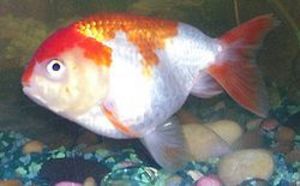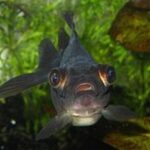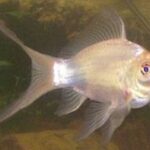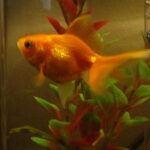Lionhead goldfish are goldfish without dorsal or top fins. Their bodies are egg-shaped and their fins are comparatively small in comparison with their bodies. This makes them far slower swimmers than common or comet goldfish. For this reason, they are best kept with either other lionheads or slow-swimming fancy goldfish like ranchus or orandas.
Although called lionheads, lionhead goldfish lack a lion-like mane. They do grow a bumpy hood on their heads when they are at last a year old. But lionheads originated in China. They get their nickname from looking like a Chinese mythological creature called a lion-dog. A similar creature called a “shishi” appears in Japanese folklore and art. The Japanese are also avid goldfish breeders.
Color
Lionhead goldfish sold in pet stores tend to be juveniles less than six months old. They are about an inch long and have almost perfectly smooth heads and dorsal area. But lionheads can grow up to six inches. Anyone considering buying or adopting a juvenile lionhead should realize how large they can grow.
Lionheads may also change color as they get older, so do not choose a lionhead just on the basis of color, unless it is an adult. Color changes from juvenile to adult can happen to many types of goldfish, including the common goldfish. Lionheads come in a variety of colors, including gold and white, red and white, calico, black and gold, all gold and all black. New colors and patterns are being developed.
General Appearance
There are a lot of physical variations to lionheads. Some will have scales that press firmly to the sides, such as seen in a common goldfish. But some will have pearlescent scales that stick out slightly like rows of pearls. The hood can cover just the top of the head or the entire face and can sometimes resemble a raspberry in shape.
As mentioned before, the fins are quite short, except for a rare variety called a “shukin” that has long fins. The tail or caudal fins in particular are about three-quarters the length of the fish’s body. In both long-finned and short-finned varieties, the tail is forked and split. This also makes for a fish that swims slower than common goldfish.
Lionhead goldfish are not for beginning fish keepers. They are prone to swim bladder problems because of the unnatural shape of their bodies and fins. Constipation can be a major cause of swim bladder problem in goldfish, so it is important to never overfeed, although it is very tempting not to give in to those begging eyes.
Since lionheads are not as agile as other types of goldfish, they can blunder into decorations and injure themselves. Make sure decorations are soft and rounded. Some fish keepers avoid decorations altogether, except for a plastic plant where the fish can hide if stressed.
References:
“Goldfish: A Pet Owner’s Manual.” Marshall Ostrow. Barron’s; 1995.
“Goldfish.” Bernice Brewster and Nick Fletcher.” Bow Tie Press; 2004.
American Goldfish Association. “Finnage in Goldfish.” http://www.americangoldfish.org/Articles/Finnage%20in%20Goldfish.pdf
Personal experience






